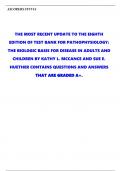Exam (elaborations)
THE MOST RECENT UPDATE TO THE EIGHTH EDITION OF TEST BANK FOR PATHOPHYSIOLOGY: THE BIOLOGIC BASIS FOR DISEASE IN ADULTS AND CHILDREN BY KATHY L. MCCANCE AND SUE E. HUETHER CONTAINS QUESTIONS AND ANSWERS THAT ARE GRADED A+.
Course
BIOLOGIC BASIS FOR DISEASE IN ADULTS AND CHILDREN
Institution
BIOLOGIC BASIS FOR DISEASE IN ADULTS AND CHILDREN
THE MOST RECENT UPDATE TO THE EIGHTH EDITION OF TEST BANK FOR PATHOPHYSIOLOGY: THE BIOLOGIC BASIS FOR DISEASE IN ADULTS AND CHILDREN BY KATHY L. MCCANCE AND SUE E. HUETHER CONTAINS QUESTIONS AND ANSWERS THAT ARE GRADED A+.
[Show more]
Preview 10 out of 935 pages
Uploaded on
July 26, 2024
Number of pages
935
Written in
2023/2024
Type
Exam (elaborations)
Contains
Questions & answers
biologic basis for disease in adults and children
the most recent update to the eighth edition
of test bank for pathophysiology the biologic bas
Institution
BIOLOGIC BASIS FOR DISEASE IN ADULTS AND CHILDREN
Course
BIOLOGIC BASIS FOR DISEASE IN ADULTS AND CHILDREN
$15.99
Also available in package deal from $22.99
100% satisfaction guarantee
Immediately available after payment
Both online and in PDF
No strings attached
Also available in package deal (1)
1. Exam (elaborations) - Test bank for pathophysiology 7th edition by jacquelyn l. banasik chapter 1-54|comple...
2. Exam (elaborations) - Pathophysiology chapter 1 complete review study guide with summary notes at end of th...
3. Exam (elaborations) - Patho final test bank newest updated multiple & single choice questions combo high pr...
4. Exam (elaborations) - Test bank for pathophysiology the biologic basis for disease in adults and children 7...
5. Exam (elaborations) - Pathophysiology chapter 16 - test bank multiple choice questions with correct answers...
6. Exam (elaborations) - The most recent update to the eighth edition of test bank for pathophysiology: the bi...
7. Exam (elaborations) - Pathophysiology exam 1 test bank newest exam update; questions with correct answers a...
Show more
ASCORERSSTUVIA




